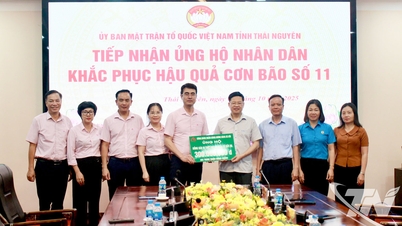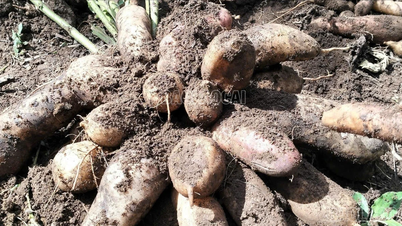
Mrs. Tran Thi Dung and her husband, residing in Tan Hiep commune, pack rice paper to send to customers. Photo: HUONG GIANG
The old profession is still there
On sunny days, along the small roads leading to Tan Hiep commune, it is not difficult to see familiar images: Pure white rice paper is dried on bamboo racks, nets all over the yard. The sound of laughter, the crackling sound of the kitchen fan, the sound of wind blowing on the rice paper... creates a peaceful, vibrant scene.
The rice paper making profession in Tan Hiep has been around for decades, mainly concentrated in Tan Hiep commune and some neighboring communes. The profession has been passed down through many generations, from grandparents, parents to children. Nearly 60 years old, Mrs. Pham Thi Mau, a resident of Tan Hiep commune, still wakes up at 2am every day to prepare for a new day by the fire and make rice paper with the fragrant smell of new rice. She is one of the "old trees" of the rice paper making profession.
After nearly 30 years of working in the profession, Mrs. Mau has made hundreds of thousands of cakes, supporting her family and maintaining the traditional profession her grandparents left behind. Mrs. Mau said: “Every day I make nearly 300 cakes, selling them to customers at markets, shops, and everywhere. Each cake sold only brings in a profit of a few thousand dong, but I am happy to still maintain the profession my grandparents left behind.”
Although the job of making rice paper is hard, requiring workers to wake up at dawn, their hands and feet always nimbly next to the hot stove and the batches of dough still wet, for the past 30 years, Mrs. Tran Thi Dung, living in Tan Hiep commune, has never once thought of quitting the job. There were days when it suddenly rained out of season, causing the basket of rice paper not to dry yet to have to be thrown away, Mrs. Dung felt regretful. On days when the weather changed, her bones and joints ached, she still tried to wake up early, light the fire, and make each rice paper as a habit ingrained in her blood. "The job of making rice paper supports the whole family, how can I give it up. It's not just a meal, it's also a memory, a family tradition," Mrs. Dung said. For her, each batch of rice paper is a joy, each day of working is happiness.
In the late afternoon, the wind from the fields blew through the bamboo trellis, making the drying cakes emit a gentle aroma of rice mixed with sunlight. Mrs. Mau busily gathered each dried cake, saying: “It is hard work, but this job has been closely attached to my life. As long as I am healthy, I will continue to do it, I cannot give it up.”
The cake carries the soul of the earth and the taste of heaven.
Each rice paper here is the crystallization of a meticulous, elaborate process that the craftsman has devoted all his heart to. From choosing the best rice, usually dry season rice, with even grains and a light fragrance, to the steps of soaking, grinding, mixing the flour and then spreading the rice paper in just a few seconds on a layer of hot steam, everything requires skill and experience. The rice paper is evenly thin and is brought out to dry in the sun, on bamboo racks, large nets, where a gentle breeze blows. "If the rice paper is too thick, it will be tough, if it is too thin, it will break, if it is dried in too little sunlight, it will become moldy, if it is dried for too long, it will become brittle and broken. This job requires the craftsman to be patient", said Mr. Tran Ngoc Son, a resident of Tan Hiep commune.
Sunlight is the key to making Tan Hiep rice paper crispy, delicious, and free of mold. The baker must monitor the weather and carefully calculate each sunny day, because if it rains for a long time, the finished batches of rice paper can be spoiled, all the effort will be in vain.
Each Tan Hiep rice paper is not only a product of traditional craft but also a taste of the earth, of hard work and love for the homeland. It holds the stories of the grandfathers, grandmothers, mothers and the young people who still work hard to preserve the traditional craft every day.
Tan Hiep rice paper is favored by many consumers because of its natural delicious taste, no preservatives, and rustic countryside flavor. Among them, Mrs. Mau's rice paper is famous not only in Tan Hiep but also in many places inside and outside the province. The crispy, fatty cakes that retain the old flavor have become a typical brand, captivating many diners. Anyone who has ever enjoyed Mrs. Mau's rice paper will forever remember that unforgettable traditional flavor. Ms. Phuong, a resident of Tan Hiep commune, shared: "I often buy Mrs. Mau's rice paper to treat guests from far away and as gifts for friends. The cakes are crispy, fragrant, and have a moderate fatty taste, a characteristic that cannot be found elsewhere. My friends who receive the cakes all like them because they are not only delicious but also have a strong hometown flavor."
Although still maintaining the traditional manual process, rice paper production facilities in Tan Hiep have begun to focus on investing in packaging, registering trademarks and building brands to expand the market. Not only stopping at the provincial markets, Tan Hiep rice paper is present in many provinces and cities in the Western region, appearing on shelves in Ho Chi Minh City. Many children far from home buy a few dozen rice paper as gifts for friends and relatives every time they return home.
Amidst the wave of modernization spreading across the countryside, Tan Hiep still has people who keep the fire burning and the profession. The rice paper is a place to preserve memories, love of the homeland and the aspirations of many people. When people far away from home remember Tan Hiep, the smell of rice paper drying in the sun with the aroma of new rice will still be the first memory that comes back, as an affirmation that the homeland is still here in each crispy cake, carrying the soul of the earth and the taste of heaven.
HUONG GIANG
Source: https://baoangiang.com.vn/thom-tinh-dat-dam-hon-que-a463539.html



![[Photo] Unique Phu Gia horse hat weaving craft](https://vphoto.vietnam.vn/thumb/1200x675/vietnam/resource/IMAGE/2025/10/10/1760084018320_ndo_br_01-jpg.webp)
![[Photo] Opening of the World Cultural Festival in Hanoi](https://vphoto.vietnam.vn/thumb/1200x675/vietnam/resource/IMAGE/2025/10/10/1760113426728_ndo_br_lehoi-khaimac-jpg.webp)
![[Photo] Ho Chi Minh City is brilliant with flags and flowers on the eve of the 1st Party Congress, term 2025-2030](https://vphoto.vietnam.vn/thumb/1200x675/vietnam/resource/IMAGE/2025/10/10/1760102923219_ndo_br_thiet-ke-chua-co-ten-43-png.webp)


































































































Comment (0)